Renaissance Art
Renaissance art is a component of the Renaissance is a period of renewed literary, artistic, and scientific, which occurred in Europe in the sixteenth century.
A key aspect of the Renaissance period as is the renewal of subjects and the arts in Europe after the Middle Ages. Provide specific time limits for this art movement is difficult. It is commonly accepted that the artistic Renaissance began in Italy in the fifteenth century and then spread throughout the continent, at different rates and different degrees depending on geography.
It extends the sixteenth century and then achieved in many countries its peak. The Renaissance is not a reversal: new techniques, the new political, social and scientific enable artists to innovate. For the first time, the art enters the private sphere: the works are not only controlled by the religious and secular power, but entering the town houses.
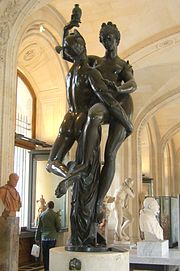
Mercure removing Psyche, by Adrian de Vries. Mercury was the god of merchants in ancient Roman
Ideas and creative subjects
Humanism and artistic production
While in medieval artistic creation was essentially geared towards Christianity, the Renaissance artistic uses humanistic themes (tolerance, freedom of thought, peace, education for the development of the individual, etc.). And the mythology ancient. The renewal of philosophical reflection provides artists with new ideas: with Neoplatonism, Man is the center of the universe. Painters and sculptors do not hesitate to represent the beauty of the naked human body. The study of ancient texts, the renewal of philology with Lorenzo Valla, allowing architects to get rid of the Gothic style. They use the teachings of Pythagoras and Vitruvius to develop their plans. The thought is released gradually religious constraints and turns to the aspirations for happiness, peace and progress. Writers and philosophers now interested in all fields of knowledge. They copy down and translate manuscripts and looking for new texts. These ideas are spreading renewed on the European continent through the printing and travel humanists. The first libraries were created such as the Vatican Apostolic Library (circa 1450).
Rediscovery of Antiquity

A mythological theme of the Renaissance: Diana, Roman goddess of hunting, XVI century, Musée du Louvre
With the arrival of artists and compilations Byzantine, fleeing the Ottoman invasion, Vegetius, Pythagoras, Euclid are again available in their original Greek manuscripts. Printing using Roman characters. In art, the nude is more widely used in the Middle Ages and the movement is rendered realistically by the hips.
Vogue of the Greco-Roman mythology
The Renaissance artists re-read the myths of pagan antiquity that give them new areas of production. Archaeological findings (group of Laocoon), as the excavations of the Baths of Caracalla by Farnese, inspire sculptors and architects of the fifteenth and sixteenth centuries. The villa of the emperor Hadrian or the Roman Pantheon offer models of radically different construction of the Gothic style. The forms of antiquity back in fashion: columns, pilasters, pediments, domes, statues decorate the buildings of that period. The Old Testament and Catholic Christianity always inspire works of art.
New technical means
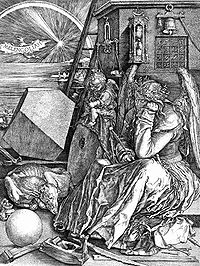
Albrecht Dürer, Allegory of Melancholy: A new theme and a new technique, the etching
The advance of science benefits the arts throughout the fifteenth century, painters mastered increasingly linear perspective and proportion. In XIV century, the advent of oil paint gives more depth to the works. The use of paintings gradually replaces the wooden support. Leonardo da Vinci's Mona Lisa performs with the effects of sfumato. The invention of printing in the middle of the fifteenth century and new techniques engraving (woodcut) authorize the reproduction and dissemination of works on the continent. The prints are proliferating in books and replace the precious illuminated medieval manuscripts.
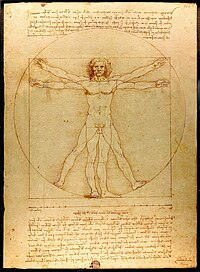
Leonardo da Vinci, a page of sketches on human anatomy
Arts and Sciences
There was marked progress in medicine and anatomy, especially after the first translation of many ancient works of Hippocrates and Galen to the XV and XVI centuries, and the progress made under the auspices of ancient authors include resolution of equations of the third degree and the astronomical discoveries of Nicolas Copernicus, of Tycho Brahe and Johannes Kepler. At the end of the sixteenth century, Galileo had made the leap and applied mathematical models for physics. The geography was transformed by a new empirical knowledge derived from explorations beyond Europe and the first translations of ancient works of Ptolemy and Strabo. The knowledge is then applied in drawing, painting and sculpture, as evidenced by the famous Vitruvian Man by Leonardo da Vinci or engravings of Dürer. It is then possible to define a system of ideal proportions and accurately represent a human body. The paintings and frescoes are more realistic than in the Middle Ages.
A context for the revival of arts
Return to growth
After the demographic decline of the fourteenth century and the first half of the fifteenth century, Europe's population begins to return to its pre-crisis. Even if outbreaks are recurrent in Europe until the eighteenth century, the great black plague has receded. The famines are farther apart. The high densities that occur in the sixteenth century in Flanders and northern Italy are conducive to an intensification of work. The Hundred Years War ended in 1453 and castles will leave gradually replaced by pleasure palace. Between 1500 and 1580, the climate seems milder before cooling again during the Little Ice Age. With the discovery of the America in 1492, gold and silver flowing into Europe and promote economic recovery. The major travel and maritime commerce enable the growth of large cities and beautification.
Patrons allow artists to practice their art

Verrocchio, Bust of Lorenzo de Medici, a patron. Stored at the National Gallery of Art, Washington DC
The princely courts are the ideal setting for the flowering of Renaissance culture. In the arts, many patrons were important collections. They all belong to the aristocracy of power (princes, dukes, kings, pope) and economy (large traders who invest their money in the artistic production).
The Medici: Lorenzo the Magnificent supports the artistic creation of Verrocchio and Botticelli.
Orders of Montefeltro covers areas as diverse as bibliophile, tapestries and paintings.
Ludovico Sforza (in 1452 - 1,508), Duke of Milan, made work of Leonardo da Vinci and Bramante.
The popes are working artists of the Renaissance in Rome: Michelangelo painted the Sistine Chapel, Alexander VI Borgia (1,492 - 1503), Julius (1503 - in 1513), Leo X (in 1513 - in 1521), Paul III Farnese (1534 - 1549)
In France, the wars of Italy are an occasion for kings to make contact with the art of the Renaissance and loot some of his masterpieces. Francis I invited Italian artists (Leonardo da Vinci at Amboise, Benvenuto Cellini, Rosso Fiorentino, Primaticcio at Fontainebleau ...).
The merchants also become lovers of art: Jacques Heart of France in the fifteenth century century, the rich Italian banker Roberto Strozzi in 1489 ...
A geography of the Renaissance
Historians agree that Renaissance art was born in Italy in the fifteenth century (some even speak of a pre-Renaissance in the fourteenth century) and has played in the continent mainly in XVI century . The conditions of the Renaissance were specific: the peninsula was divided into several principalities, each competing who would shine brighter than others, which encouraged the creation and artistic emulation.
Then, Italy focused mainly ancient Roman heritage, especially since Greece was under Ottoman rule. Finally Italy is urbanized and enriched by the trade long ago. It acts as a magnet for artists, merchants and religious (Rome) in Europe. The diaspora in Italy is important in large Western cities since the Middle Ages.
The Italian art was not the only reference in the Renaissance: Burgundian homes and Flemish were also influential. Painters and decorators Flemish have left their mark on the European courts of the sixteenth century.
Central and Eastern Europe
The history of the Germanic countries is marked by the development of printing by Gutenberg and the success of burning (Schongauer, Albrecht Dürer). Sculpture flourished between 1460 and 1520. The altar painting is at its peak with Mathias Grünewald. The merchant and banker Jacob Fugger often went to Venice and falls under the charm of Italian Renaissance art. It accommodate a chapel at Augsburg, expression of a specifically German Renaissance architecture. In 1548, Titian was established in this city and painted portraits in the commercial middle class. With the Reformation, a movement iconoclastic spreads and destroys religious works in the Germanic countries. The Eastern Europe was probably less receptive to the Italian model. Some Italian artists worked in Moscow, but they were few. The Orthodox territories looking more towards Byzantium to Rome. They are of Slavic culture and use Cyrillic. From 1453, Constantinople passes into the hands of Ottoman Turks. In the second half of the fifteenth century, the Hungarian King Matthias Corvinus organizes a brilliant court and a famous library in Buda. Vienna knows the destruction caused by the Ottomans in 1529. Then Ferdinand of Habsburg (1503-1564) introduced the Italian art of his court Hofburg. In Prague, Rudolph of Habsburg (1552-1612) surrounded by artists Mannerist such as Bartholomeus Spranger (1546-1611), Giuseppe Arcimboldo (1527-1593), Hans von Aachen (1552-1615), and Adrien de Vries .
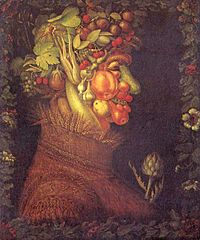
Giuseppe Arcimboldo, Summer, Musée du Louvre
France: a Renaissance origin

Bas-relief of Jean Goujon
In addition, the Italian model was struck to adapt to even national resistance: Protestants reject the Roman model. In France elaborated an original synthesis between contributions Italians and French medieval tradition. Du Bellay Italianization denounced the French language. If the Chambord castle is built on a focused, few French architects to adopt this model. The chateau of Azay-le-Rideau retains the round towers of medieval style. The Chateau de Chenonceau, Fontainebleau, Chantilly, Anet or Gaillon are not symmetrical. Especially the grounds and Italian decor that develop, following the wars of Italy. Philibert Delorme even wanted to create an architectural order French. Jean and François Clouet, of Flemish origin, are serving Valois. Jean Clouet carries a portrait of the humanist Guillaume Bude.
Italy
The Renaissance in Italy early (compared to the rest of Europe and particularly in France):
According to art historians, it begins to Duecento (XIII century) or Trecento (XVI century) by a period called the Pre-Renaissance (According to art historian Jacob Burckhardt, the Renaissance before the hours starting from the eleventh century in Tuscany and spreads until the next century Provence and Italy median) and continues in full by the early Renaissance in Quattrocento.
It turns into High Renaissance in the early Cinquecento (between 1500 and 1530), followed by Mannerism or Late Renaissance ranging from 1520 (Raphael's death) to finish in early 1580.
The Baroque, which begins at the turn of the sixteenth and seventeenth centuries, also born in Italy, then continues into late Baroque, appointed specifically Rococo period (which is followed by neoclassicism).
Netherlands and Scandinavia

Hans Holbein the Younger, Portrait of Thomas More, now in New York, Frick Collection
In painting, the landscapes are not necessarily old, but reproduce the regional environment: Quentin Metsys painted a northern rural scenery behind the Virgin and Child with Lamb (1515 - 1524). Also in northern Europe, Pieter Bruegel the Elder, Pieter Aertsen and Joachim Patinir embody resistance to Italian themes.
In the fifteenth century, the prosperity of Bruges is manifested in the wool trade, but also in the arts: Jan van Eyck, Hans Memling and Gerard David moved there. The Burgundian Netherlands remain the main center of production of tapestries in Europe.
Robert Campin and Rogier van der Weyden produce paintings for the altars of churches. Hugo van der Goes (1435 / 45 - 1482) painted a triptych for the Florentine banker Tommaso Portinari. In the early sixteenth century, Antwerp Bruges eclipse as a financial and commercial. Metsys Quentin (1465 / 66 - 1530), Joachim Patinir (1475 / 85 - 1524) and Pieter Bruegel the Elder (1525 / 30 - 1569) work and represent the bourgeoisie. The painter Jan Gossaert visited Italy and distributes its way into the Spanish Netherlands. Scorel Jan van (1495-1562) was influenced by Raphael and Michelangelo. Philip II of Spain bought the paintings of the Flemish masters Rogier van der Weyden and Hieronymus Bosch. In the second half of the sixteenth century, Pieter Bruegel the Elder specializes in genre painting. In 1566, a wave of iconoclasm Protestant cause significant damage in the cathedral of Antwerp.
England
In the British Isles, Renaissance art can begin to flourish after the Wars of the Roses (1485) and the emergence of English naval power. The first printing press was installed in 1476 at Westminster by William Caxton. Hans Holbein the Younger worked in London from 1532. It carries the portrait of the English humanist Thomas More. The German merchants of the Hanseatic League and the King Henry VIII of England are its main customers. The monarch made see the Palace of Whitehall and of Hampton Court, and build Nonsuch Palace.
Iberian Peninsula
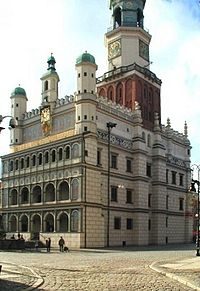
Poznan
In the arts Iberian, the Arab influences are visible in the early fourteenth century. The kingdom of Granada remains in the hands of Nasrid until 1492. Gil of Siloam, probably originating in the Netherlands, working for the King of Castile and still respects the Gothic tradition. But his son Diego of Siloam (second half of the sixteenth century) is inspired by the Italian Renaissance by adopting the symmetry. Guas Juan (1430 - 1496), architect to the court of Isabella the Catholic, drew the plans of the monastery of San Juan de los Reyes in Toledo. The Plateresque, which is characterized by a profusion of ornament, is very popular in Spain in the sixteenth century. After the Council of Trent, the cons-reform is felt in the arts (art Jesuit) and literary (Juan de la Cruz, Teresa of Avila). In 1561, Philip II installed his court to Madrid and built the Escorial. It acquires Italian paintings as well as Flemish. Finally, in the 1570s, the Greek painter El Greco settled in Toledo, his work mixes elements Byzantine and Venetian. In Portugal, the Manueline style reflects the opening of maritime country since Henry the Navigator.